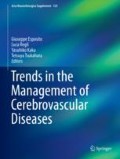Abstract
In this first population-based study of moyamoya disease (MMD) in Europe, the authors identified 56 patients with MMD in Denmark during the period 1994–2015 using nationwide registers. The overall incidence was 0.047 per 100,000 person-years, which is about one-tenth that reported in Japan. Otherwise the epidemiological features were comparable: there was a bimodal age distribution with peaks in the age groups 0–9 years and 30–39 years, with twice as many females as males.
Access this chapter
Tax calculation will be finalised at checkout
Purchases are for personal use only
References
Scott RM, Smith ER. Moyamoya disease and moyamoya syndrome. N Engl J Med. 2009;360:1226–37.
Birkeland P, Gardner K, Kesse-Adu R, Davies J, Lauritsen J, Rom Poulsen F, Tolias CM, Thein SL. Intracranial aneurysms in sickle-cell disease are associated with the hemoglobin SS genotype but not with moyamoya syndrome. Stroke. 2016;47:1710–3.
Hansen RN, Andersen G, Longin E. Moyamoya. Ugeskr Laeger. 2011;173:281–2.
Kondziella D. Diagnosis and treatment of rare causes of ischaemic stroke. Ugeskr Laeger. 2016;178:V02160101.
Baba T, Houkin K, Kuroda S. Novel epidemiological features of moyamoya disease. J Neurol Neurosurg Psychiatry. 2008;79:900–4.
Hoshino H, Izawa Y, Suzuki N. Epidemiological features of moyamoya disease in Japan. Neurol Med Chir (Tokyo). 2012;52:295–8.
Wakai K, Tamakoshi A, Ikezaki K, Fukui M, Kawamura T, Aoki R, Kojima M, Lin Y, Ohno Y. Epidemiological features of moyamoya disease in Japan: findings from a nationwide survey. Clin Neurol Neurosurg. 1997;99(Suppl 2):S1–5.
Acker G, Goerdes S, Schneider UC, Schmiedek P, Czabanka M, Vajkoczy P. Distinct clinical and radiographic characteristics of moyamoya disease amongst European Caucasians. Eur J Neurol. 2015;22:1012–7.
Hever P, Alamri A, Tolias C. Moyamoya angiopathy—is there a Western phenotype? Br J Neurosurg. 2015;29:765–71.
Kleinloog R, Regli L, Rinkel GJ, Klijn CJ. Regional differences in incidence and patient characteristics of moyamoya disease: a systematic review. J Neurol Neurosurg Psychiatry. 2012;83:531–6.
Lynge E, Sandegaard JL, Rebolj M. The Danish national patient register. Scand J Public Health. 2011;39:30–3.
Uchino K, Johnston SC, Becker KJ, Tirschwell DL. Moyamoya disease in Washington State and California. Neurology. 2005;65:956–8.
Kossorotoff M, Herve D, Toulgoat F, Renaud C, Presles E, Chabriat H, Chabrier S. Paediatric moyamoya in mainland France: a comprehensive survey of academic neuropaediatric centres. Cerebrovasc Dis. 2012;33:76–9.
Research Committee on the Pathology and Treatment of Spontaneous. Occlusion of the Circle of Willis, Health Labour Sciences Research Grant for Research on Measure for Infractable Diseases. Guidelines for diagnosis and treatment of moyamoya disease (spontaneous occlusion of the circle of Willis). Neurol Med Chir (Tokyo). 2012;52:245–66.
Wermuth L, Lassen CF, Himmerslev L, Olsen J, Ritz B. Validation of hospital register-based diagnosis of Parkinson’s disease. Dan Med J. 2012;59:A4391.
Author information
Authors and Affiliations
Corresponding author
Editor information
Editors and Affiliations
Ethics declarations
Ethical Approval
For this type of study formal consent is not required.
Conflict of Interest
The authors declare that they have no conflict of interest.
Funding
This study was supported by a grant from Ingeniør K.A. Rohde of Hustrus Legat.
Rights and permissions
Copyright information
© 2018 Springer International Publishing AG, part of Springer Nature
About this paper
Cite this paper
Birkeland, P., Lauritsen, J. (2018). Incidence of Moyamoya Disease in Denmark: A Population-Based Register Study. In: Esposito, G., Regli, L., Kaku, Y., Tsukahara, T. (eds) Trends in the Management of Cerebrovascular Diseases. Acta Neurochirurgica Supplement, vol 129. Springer, Cham. https://doi.org/10.1007/978-3-319-73739-3_13
Download citation
DOI: https://doi.org/10.1007/978-3-319-73739-3_13
Published:
Publisher Name: Springer, Cham
Print ISBN: 978-3-319-73738-6
Online ISBN: 978-3-319-73739-3
eBook Packages: MedicineMedicine (R0)

